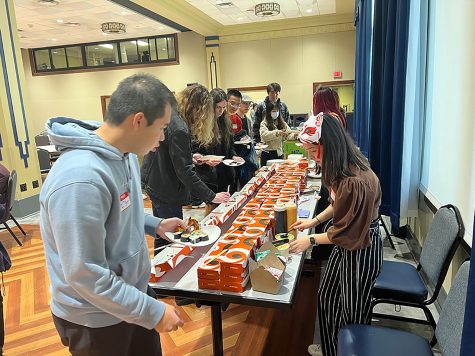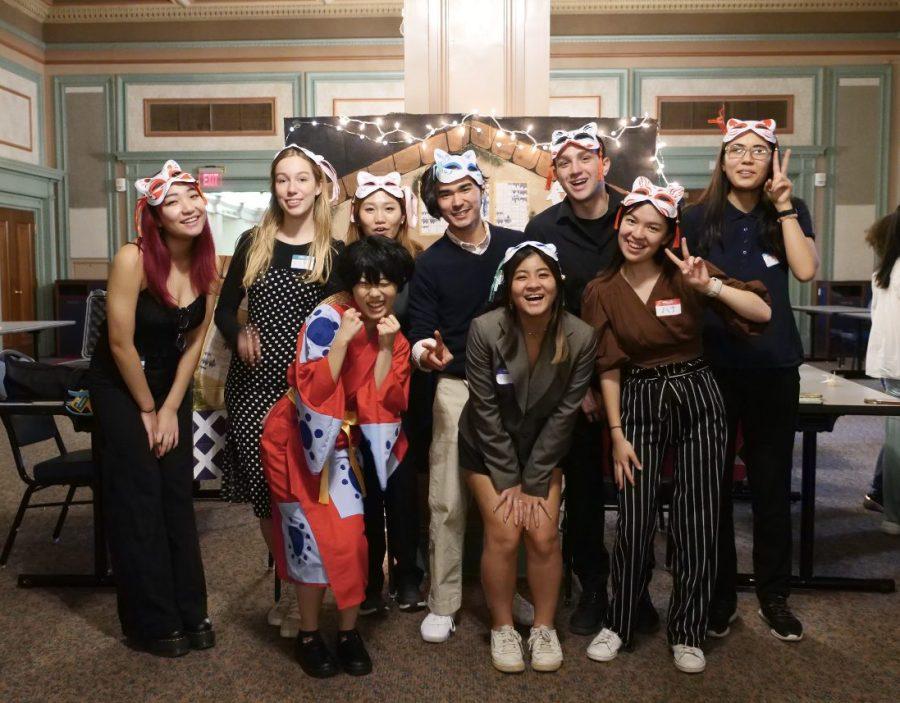JSA’s Bunkasai celebration educates students about Japanese culture
Image courtesy of the Japanese Student Association at Pitt, photo by Megumi Barclay
Members of the Japanese Student Association at Pitt pose for a group photo during their Bunkasai in the William Pitt Union on Saturday.
October 30, 2022
For Austin Kellar, Bunkasai is a way for the Japanese Student Association to celebrate Japanese culture.
“[Bunkasai] celebrates how important Japanese culture is, and Japan’s relationship with America,” Kellar said. “It’s just enjoyable to be appreciative of another culture than your own that you grew up with.”
Pitt’s JSA hosted their annual Bunkasai event in the William Pitt Union on Saturday, with about 100 people in attendance. Because the event took place during Halloween weekend, JSA opted to theme the party “Yokai,” to not only indulge in Japanese culture, but experience some spookiness as well.
Kellar, a junior Japanese and English literature double major, said Yokai are supernatural beings and ghosts in Japanese folklore.
“Yokai are basically apparitions. They originate from Japanese folktales. So, they can either be like creatures like Hitosume Kozo, who was on our Instagram, or Kappa, the turtle-looking one. Or they can also be ghosts,” Kellar said. “They are basically any supernatural thing — ghost, creature, god.”
The event began with a slideshow highlighting the importance of Bunkasai and Yokai. The event continued with a performance showcase which featured seven performances that highlighted different parts of Japanese culture.
Kellar, JSA’s social media and public relations co-chair, said Bunkasai is a cultural festival generally held in high schools across Japan. While living in Japan during high school, he said each grade typically picked a part of the festival they can contribute to, such as food, haunted houses and decorations, and the classes came together to bring their festival to life.
“Japanese high schools, you have to apply to get into them. Like how we apply to college, they apply to high school. So this is also an event to promote their school for people who are graduating middle school to be like ‘Oh, I want to go to that high school,’” Kellar said. “So they promote Japanese culture, but also their school pride.”
Kellar said for JSA, the organization’s main priority of the event is showcasing Japanese culture to other students.

“Bunkasai for me is the chance for us, as JSA board and just JSA in total, is our main chance to show the greater Pitt population a different culture. And give them a chance to look into a culture they may not know much about,” Kellar said.
The showcase kicked off when the JSA board performed a dance from the soundtrack of a famous anime, “Yo-kai Watch!” followed by a performance by a graduate music student, Devon Tipp.
Tipp played the shakuhachi, the traditional Japanese bamboo flute, and their set featured two different Japanese songs. The event also featured a dance performance by Pitt’s student-run Asian pop dance club, FRESA.
The showcase also highlighted another aspect of Japanese culture 一 martial arts. Pitt’s Kendo Club gave attendees insight into Japan’s modern martial art, kendo, also known as “the way of the sword” or even Japanese fencing. The Kendo Club showed off their skills by running some drills and even allowed the crowd to witness a slow demonstration of how a kendo match is typically run. Once the performances concluded, the event then shifted its focus to another intricate part 一 the booths.
Natalia Lialine, JSA president and a senior math economics major, said people can learn about different aspects of Japanese culture through the performances.
“From the different performances, people can learn about different aspects of Japanese culture. We’ve tried to feature different [kinds] of performances, not just dance performances or singing performances,” Lialine said.
Attendees made their way into the Kurtzman room to discover a variety of booths highlighting Japanese food, toys, calligraphy and Yokai. The booths also included some other cultural clubs under the Asian Student Alliance umbrella, such as Korean Student Association, Filipino Students Association, Chinese American Student Association and Vietnamese Student Association.
Susan Choy, a senior biology and sociology double major, said she heard about Bunkasai through a friend. As a member of the Filipino Student Association, Choy said she wanted to support JSA by attending the event.
Choy said one of her favorite booths was JSA’s advocacy booth.
“It’s where you spin a wheel, and it lands on a picture,” Choy said. “Then the person standing there tells you the tale or the superstition surrounding that picture, and you have to guess whether it originated from Japanese culture or not. I thought that was cool. It’s a little fun fact.”
The calligraphy booth had two parts 一 one where attendees received a nametag written in katakana, Japanese calligraphy, and another where they were shown a kanji character for three seconds and tried to draw it from memory.
Using their Stamp Rally paper, which they received on arrival at the event, attendees walked around the room visiting each booth to learn more about Japanese culture and in return earn a stamp. Once they collected six stamps, attendees were able to redeem their paper for some free sushi.
Choy said she was excited to see JSA embracing and celebrating Japanese culture at Bunkasai.
“I think it’s delightful to see people embracing their culture, and when they don’t usually get to. I think that’s awesome,” Choy said.








